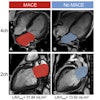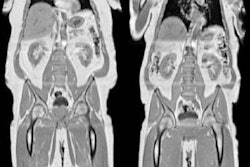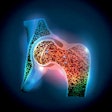
Body composition analysis on CT lung cancer screening exams can identify patients at risk of death or hospitalization in the coming years, according to a presentation at the virtual Chest 2021 meeting.
After retrospectively measuring body composition on CT lung cancer screening studies in over 1,700 patients, researchers from Lahey Hospital and Medical Center in Burlington, MA, found that patients in the lowest quartile on two measures -- pectoralis muscle area and liver density -- were both associated with future admission to the hospital due to chronic obstructive pulmonary disease (COPD).
In addition, patients in the lowest quartile of pectoralis muscle area measurements had a higher risk of death, while the lowest quartile for liver density measurements was associated with an increased risk for all-cause hospital admission and pneumonia-related hospital admission, according to presenter Dr. Alissa Ali.
Patients who are considered at risk for lung cancer are also at high risk for cardiopulmonary complications, Ali noted. As muscle area quantified on CT exams has previously been associated with mortality, lung cancer, and COPD severity and exacerbations, the researchers sought to determine if CT quantitative body composition analysis in a CT lung cancer screening population could identify those at risk for mortality, as well as all-cause, COPD, and pneumonia-related hospitalizations.
To accomplish this goal, they retrospectively analyzed 1,703 patients who had received CT lung cancer screening at their institution between January 1, 2012, through September 30, 2014. Clinical outcomes data was collected on these patients through September 30, 2019.
Using a single axial CT slice from each exam, the researchers performed quantitative measurements of the pectoralis muscle area, subcutaneous fat area, and liver density on the Chest Imaging Platform workstation software. The CT Slicer software was utilized to assess muscle and subcutaneous fat composition at the level where the aortic arch splits into the brachiocephalic, left subclavian, and left common carotid arteries, according to the researchers.
Results for each quantitative measurement category were divided into quartiles separated for each sex and combined to account for baseline differences, she said. The researchers then used multivariable Cox regression models to evaluate the association between quantitative measurements of the body with mortality, as well as all-cause, COPD-related, and pneumonia-related hospitalizations.
The lowest quartile of pectoralis muscle area measurements was associated with the following:
- Mortality: Hazard ratio (HR) = 3.10, p < 0.001
- COPD-related hospital admission: HR = 3.24, p = 0.004
The lowest quartile of liver density measurements were also associated with the following:
- All-cause hospitalization: HR = 1.73, p < 0.001
- Pneumonia-related hospital admission: HR = 2.95, p = 0.003
- COPD-related hospital admission: HR = 3.32, p = 0.002
Ali concluded by noting the predictive power of measurements of liver density from CT lung screening exams.
"... liver density measurements are associated with an increased risk for all-cause, COPD, and pneumonia-related hospitalizations," she said.




















